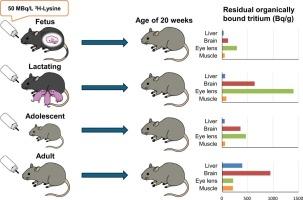Exposure to 3H-lysine during lactation causes longer retention of organically bound tritium in the lens of mouse eyes
IF 11.3
1区 环境科学与生态学
Q1 ENGINEERING, ENVIRONMENTAL
引用次数: 0
Abstract
To investigate differences in the long-term retention of organically bound tritium among organs depending on the time of ingestion, we administered drinking water containing 50 MBq L-1 3H-lysine to mice in four groups at specific stages of development for 3 weeks. Mice born to dams that had ingested 3H-lysine solution throughout pregnancy, mice fed maternal milk from dams administered 3H-lysine during lactation, adolescent mice that had ingested 3H-lysine during the growing stage, and mice that had ingested 3H-lysine during adulthood were sacrificed at the same age of 20 weeks. Subsequent measurements of tritium concentrations in organs revealed that, among the groups corresponding to different developmental stages, concentrations of organically bound tritium in the eye lens of mice fed milk from dams that had ingested 3H-lysine solution were higher than those in mice in the other three groups, whereas those in liver and muscle were higher in mice administered 3H-lysine during adulthood. These findings indicate that the hazardous effects associated with environmental tritium derived through ingestion need to be evaluated with a consideration of the stage of development at the time of exposure. To date, however, this approach has yet to be implemented in the system of radiological protection adopted by the International Commission on Radiological Protection.

在哺乳期间暴露于3h -赖氨酸会导致有机结合氚在小鼠晶状体中的滞留时间更长
为了研究不同摄入时间对有机结合氚在各器官间长期滞留的差异,我们给四组处于特定发育阶段的小鼠饮用含有50 MBq L-1 3h -赖氨酸的饮用水,持续3周。在怀孕期间摄入3h -赖氨酸溶液的小鼠,在哺乳期摄入3h -赖氨酸母奶的小鼠,在生长阶段摄入3h -赖氨酸的青春期小鼠,以及在成年期摄入3h -赖氨酸的小鼠在20周龄时被处死。随后对器官中氚浓度的测量显示,在不同发育阶段对应的组中,食用了3h -赖氨酸溶液的奶的小鼠的晶状体中有机结合的氚浓度高于其他三组小鼠,而在成年期服用3h -赖氨酸的小鼠的肝脏和肌肉中的氚浓度更高。这些发现表明,需要在考虑暴露时的发育阶段的情况下,评估通过摄入环境中氚产生的有害影响。但是,迄今为止,这一办法尚未在国际辐射防护委员会通过的辐射防护系统中得到执行。
本文章由计算机程序翻译,如有差异,请以英文原文为准。
求助全文
约1分钟内获得全文
求助全文
来源期刊

Journal of Hazardous Materials
工程技术-工程:环境
CiteScore
25.40
自引率
5.90%
发文量
3059
审稿时长
58 days
期刊介绍:
The Journal of Hazardous Materials serves as a global platform for promoting cutting-edge research in the field of Environmental Science and Engineering. Our publication features a wide range of articles, including full-length research papers, review articles, and perspectives, with the aim of enhancing our understanding of the dangers and risks associated with various materials concerning public health and the environment. It is important to note that the term "environmental contaminants" refers specifically to substances that pose hazardous effects through contamination, while excluding those that do not have such impacts on the environment or human health. Moreover, we emphasize the distinction between wastes and hazardous materials in order to provide further clarity on the scope of the journal. We have a keen interest in exploring specific compounds and microbial agents that have adverse effects on the environment.
 求助内容:
求助内容: 应助结果提醒方式:
应助结果提醒方式:


